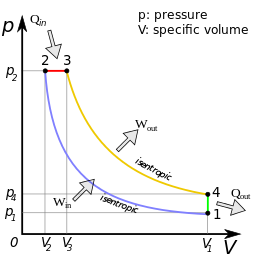Thermodynamics Review Problems for Mechanical Engineering Students | Series 19: Diesel Cycle
This is the 19th series of my "Thermodynamics Review Problems for Mechanical Engineering Students". If you've missed the previous series you may try scrolling this blog and head over to the "Curriculum". Additionally this series happens to be the 1st that tackles the Diesel Cycle. This time around, we will be computing review problems with respect to the operating conditions of each given Diesel cycle.

Review Problem 1
An air-standard engine has a compression ratio (
rk) of 15 and a cut-off ratio (rc) of 3. If the intake air pressure and temperature (P1 & T1) are 100 kPa and 28°C, find the work in kJ per kgm.Solution
For this review problem, the very first thing to obtain is the temperature at the end of isentropic compression which is
T2 and it can be obtained using the temperature and volume relation relations during isentropic compression and thankfully we are provided with the compression ratio that is equal to 15 and by using the relation, we’ve found out that T2 is equal to 889.21°K. Second thing to obtain is the temperature at the end of heat addition process which is T3 and it can be obtained using the temperature and volume relation at heat addition process for which there is a cut-off ratio (rc) for which it is provided in the review problem and by using the relation, we’ve found out that T3 is equal to 2667.63°K. If you’ve noticed in the computation below, T2 is also the temperature at the beginning of heat addition process. Next thing to obtain is the heat that is being added during the heat addition process, this time around we will be using the specific heat capacity at constant pressure (cp) and by doing so, we’ve found out that QA is equal to 1778.42 kJ/kgm, do take note that cp of air is equal to 1 kJ/kgm/°K. Next thing to obtain is the cycle efficiency of the engine and it can be obtain by using the provided rk and rc. And by using the shortcut formula, we’ve found out that the engine is 0.5581 or 55.81 % efficient. Finally, we can now obtain the work of the engine and we can do that by simply multiplying the efficiency (e) and heat that is being added (QA) to the cycle. By doing so, we’ve found out that the work that is being done by the engine is equal to 992.54 kJ/kgm.T2 |
 |
T3 |
 |
QA |
 |
e |
 |
WN |
 |
Review Problem 2
A Diesel cycle has a compression ratio of
8 and cut-off ratio of 2.5. Find the cycle efficiency.Solution
For this review problem, we will use the shortcut formula for computing the efficiency which is expressed as a function of the following: adiabatic index (
k), compression ratio (rk) and cut-off ratio (rc). And by using the shortcut formula, we’ve found out that the cycle is 0.4597 ~ 46 % efficient.e |
 |

Curriculum

Reference
- PIPE - PROBLEM SET #2 by Alcorcon Engineering Review Center
- PIPE - PROBLEM SET #3 by Alcorcon Engineering Review Center
- Sta. Maria, H. [1990] 2012. Thermodynamics 1. Mandaluyong City: National Bookstore Inc..


Postings and very good Masters with mathematical formulas, of course are very useful to learn. @josephace135
I like this post, hopefully you will stop by my blog.